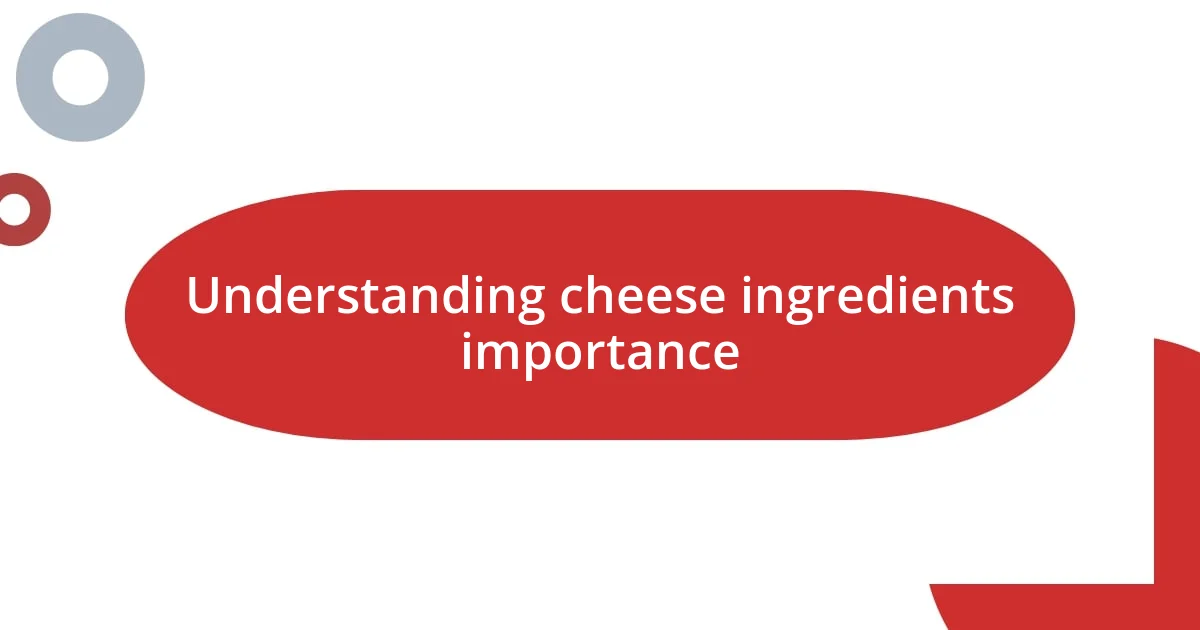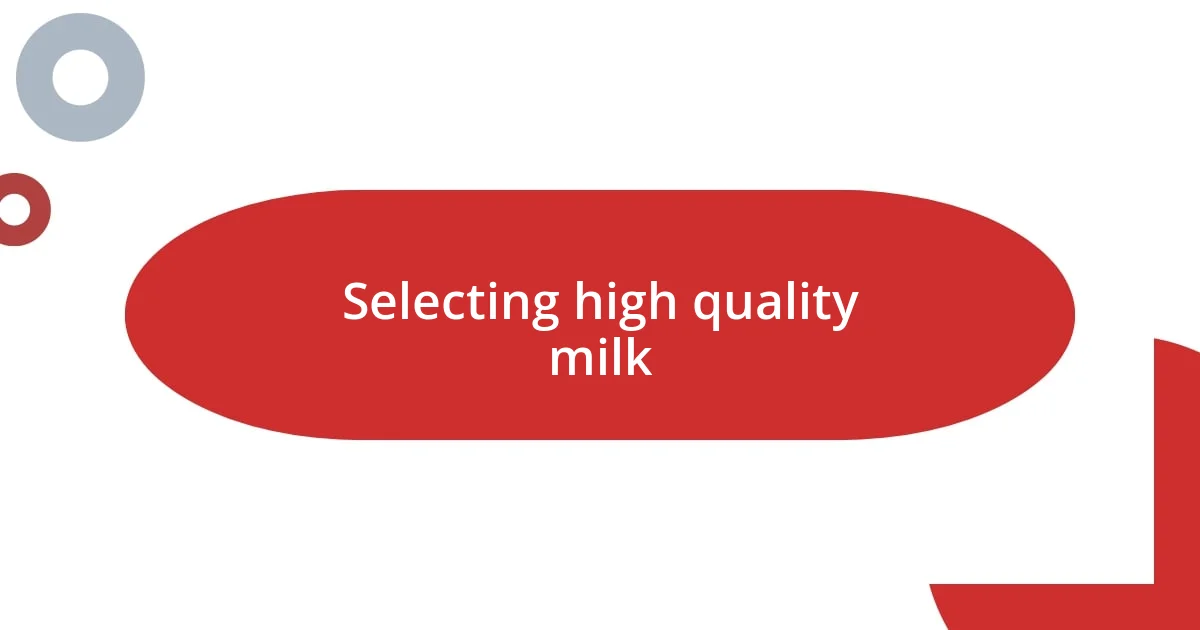Key takeaways:
- The choice of ingredients in cheese-making, including milk source and cultures, directly impacts the flavor, texture, and overall quality of the final cheese product.
- Selecting high-quality milk from grass-fed, local sources and understanding its properties (freshness, fat content, etc.) is crucial for enhancing the cheese-making process.
- Experimentation with unique ingredients and careful balancing of flavors and seasonings can lead to delightful and unexpected culinary creations.

Understanding cheese ingredients importance
When I started my cheese-making journey, I quickly realized that the ingredients are more than just components—they’re the very essence of the cheese itself. Each ingredient brings its own character, flavor, and texture, shaping the final product in a multitude of ways. Can you imagine how a simple change like switching from cow’s milk to goat’s milk could turn a creamy brie into a tangy chèvre?
The milk source, the cultures, and even the salt play crucial roles in transforming humble ingredients into something magical. For instance, the choice of cultures can determine whether your cheese has a delicate, buttery flavor or a bold, sharp bite. I remember making mozzarella for the first time and being amazed by how the live cultures produced during fermentation contributed to that exquisite stretch and richness. It really made me appreciate the science behind every bite.
Understanding these nuances not only elevates the cheese-making process but also enhances my appreciation as a consumer. Think about it—when was the last time you really considered the ingredients in your favorite cheese? By engaging with them on a deeper level, we can foster a greater love and respect for artisan cheese and the craftsmanship behind it.

Selecting high quality milk
Selecting high-quality milk is a fundamental step in creating exceptional cheese. I’ve found that the freshness and purity of milk can dramatically influence the flavor profile of the cheese. For instance, when I sourced milk directly from a local dairy farm, I could taste the difference right away. The richness and creaminess were unparalleled compared to store-bought options. That experience taught me that establishing a relationship with your milk source can greatly enhance the final product.
Here are some key points to consider when selecting high-quality milk:
- Source: Look for milk from grass-fed cows or goats, as their diet impacts the milk’s flavor and nutritional quality.
- Freshness: The sooner you use the milk after it’s been milked, the better for cheese-making.
- Raw vs. Pasteurized: Consider using raw milk for complex flavors, but ensure it meets safety guidelines.
- Fat Content: Whole milk tends to yield creamier cheeses, while lower-fat options can lead to drier textures.
- Seasonality: Milk can change with the seasons; try different batches throughout the year to discover new flavors.
Every time I take a moment to really appreciate the milk I’m using, it reminds me just how integral it is to the cheese-making process—a little care in selection can transform the ordinary into the extraordinary.

Exploring various cheese cultures
Exploring various cheese cultures is like embarking on a flavorful journey across different culinary landscapes. Each culture introduces its unique characteristics into the cheese, influencing texture, taste, and aroma. For example, I remember the first time I tried Roquefort, with its distinctive blue marbling; the blend of Penicillium roqueforti mold and sheep’s milk created an unforgettable, bold experience that I absolutely adore. It’s fascinating how every culture tells a story, reflecting the region and traditions from which it originates.
I’ve also had the pleasure of experimenting with different mesophilic and thermophilic cultures. The contrast is striking! Mesophilic cultures, typically bacteria that thrive at moderate temperatures, are essential for cheeses like cream cheese or cheddar, lending a smoother texture. In contrast, thermophilic cultures, which work best at high temperatures, are crucial for harder cheeses like Parmigiano-Reggiano. Each type brings its own personality to the cheese, transforming simple ingredients into something truly exquisite, reminding me of how diverse the world of cheese really is.
To enhance our understanding, let’s take a look at a comparison of a few popular cheese cultures:
| Cheese Culture | Typical Cheese | Key Characteristics |
|---|---|---|
| Mesophilic | Cheddar | Smooth texture, buttery flavor |
| Thermophilic | Parmesan | Hard texture, nutty flavor |
| Penicillium roqueforti | Roquefort | Bold, tangy, blue marbling |

Analyzing seasoning and flavoring
Seasoning and flavoring in cheese-making can truly transform a simple block into an unforgettable treat. I recall one particularly adventurous batch of goat cheese where I decided to incorporate fresh herbs from my garden. The combination of thyme and rosemary not only elevated the flavor but also imbued the cheese with a fragrant aroma that transported me to a sun-soaked Mediterranean village. Have you ever experienced a flavor ingredient that completely changed a dish for you? It’s those little touches that make all the difference.
When it comes to spices and herbs, the type and timing of their addition are crucial. I remember making a batch of infused cheddar and adding smoked paprika towards the end of the aging process. That choice imparted a warm, smoky flavor without overpowering the cheese’s natural goodness. Each bite had a delightful complexity that made me smile. It’s incredible how a sprinkle here or a dash there can create such a multifaceted taste experience.
I find that experimenting with flavor profiles is often a delightful surprise. Recently, I ventured into the world of sweet and savory balance by mixing in a touch of honey with sea salt in my ricotta. The sweetness against the saltiness created a beautiful harmony that left an impression on every guest at my dinner table. What flavors ignite your creativity in the kitchen? I encourage anyone to explore; you might unearth a combination that becomes a staple in your cheese-making journey.

Techniques for ingredient balancing
Balancing ingredients in cheese-making is all about understanding how different components play off one another. One time, I accidentally added too much salt to a batch of feta, thinking it would enhance the flavor. Instead, it overwhelmed the entire blend, reflecting how crucial it is to measure seasoning carefully. Have you ever had that experience where a small mistake turned into a valuable lesson?
I’ve discovered that timing can be just as important as measurement. When making a blue cheese, I once waited too long to introduce the Penicillium mold, which resulted in a lighter flavor than I had anticipated. It taught me the importance of aeration and when to introduce specific ingredients for optimal flavor development. I often wonder how every decision at each step shapes the final outcome.
Moreover, I like to experiment with acidifying agents to create a balance between creaminess and tang. A recent batch of cream cheese had a touch of lemon juice added at the perfect moment, and it transformed the texture entirely; it was both smooth and refreshingly zesty. The interaction between acidity and fat is fascinating, don’t you think? It’s these kinds of little experiments that teach me new techniques and deepen my love for cheese-making.

Experimenting with unique ingredients
Experimenting with unique ingredients opens a world of possibility in cheese-making. I remember a thrilling evening where I decided to incorporate fig and walnut into a creamy goat cheese. The luscious sweetness of the figs paired beautifully with the earthy crunch of walnuts, creating a cheese that turned an ordinary cheese board into an extraordinary centerpiece. Have you ever taken a leap of faith with an ingredient, only to be pleasantly surprised by the outcome?
One of my fondest cheese-making memories involves a batch where I dared to use exotic spices like cardamom and saffron. At first, I was hesitant; after all, these are not your typical cheese flavors. But I embraced that fear, and the result was nothing short of divine—a fragrant, floral cheese that was perfect for spreading on warm, crusty bread. It sparked conversations at my gathering, and I often wonder what other unconventional flavors might turn into my next success story.
I find that the process of experimenting is as rewarding as the finished product. A few months ago, I played around with adding a splash of craft beer to my cheddar. The rich, hoppy notes enriched the cheese’s profile, and I felt a thrill with each bite. It’s a reminder of how much joy can come from stepping outside the norm. What unique ingredients have you been itching to try? Don’t hesitate! Sometimes the most surprising flavors lead to the most memorable creations.

Reflecting on ingredient engagement results
Reflecting on ingredient engagement results can be a revealing journey into the heart of cheese-making. I vividly remember a time when I decided to blend different milk types while crafting a mozzarella. The harmony of cow’s and buffalo’s milk resulted in a creamy, yet slightly tangy cheese that left my taste buds dancing. Have you ever stumbled upon a combination that felt like a lightbulb moment in your culinary adventures?
Analyzing the outcomes after each experiment is essential for growth. For instance, when I tried incorporating smoked paprika into a cheddar, the outcome was unexpected; it didn’t just add flavor, but it transformed the entire aroma and experience. I found myself reflecting on how each ingredient I choose shapes not just the taste but also the sensory journey of the cheese. It’s fascinating how something so simple can become so complex, don’t you think?
As I continue to navigate my cheese-making path, I find that each batch teaches me something new. Recently, after experimenting with herbs, a rosemary-infused ricotta left me surprised at how the freshness brightened the cheese. It sparked a realization: each ingredient has a story and a purpose. How often do we stop to appreciate the magic of these interactions while cooking? It’s that kind of mindfulness that elevates my cheese engagements to something truly special.















